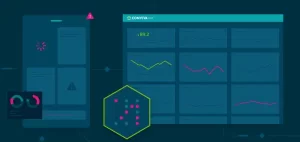BrainBlog post for Conviva by Jason Bloomberg
Time-series data is a familiar concept in the observability world. Every time an application or a system adds a record to a database or log file, it includes a timestamp that represents the precise time it created that record.
 The resulting table or file typically contains vast numbers of such records, each one representing some information at a particular point in time.
The resulting table or file typically contains vast numbers of such records, each one representing some information at a particular point in time.
Querying this information is also straightforward and can answer questions, like ‘what was the particular value of a field at some point in time’, or ‘what was the average value of a field over a specified time interval?’
Some important tasks, however, aren’t nearly as straightforward. For example, asking a simple question like ‘how long did it take a particular user to log into a web site?’ would require a surprisingly complicated SQL query – one that not only takes an inordinate amount of time to craft, but is also likely to have a difficult-to-find bug.
In the first two articles in this series, my colleague Jason English and I defined the notion of ‘quality of experience’ (QoE) and discussed how to operationalize telemetry data to achieve this QoE.
However, there’s a catch: point-in-time data is insufficient for evaluating QoE. Instead, organizations must leverage continuous time.



